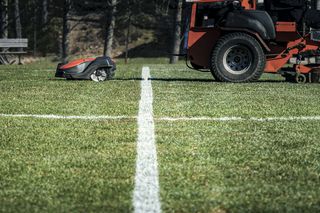How to create a championship football pitch
Leading sports grass expert Simeon Liljenberg is here to teach you the tricks that can turn almost any football field into a championship pitch.

Leading sports grass expert Simeon Liljenberg is here to teach you the tricks that can turn almost any football field into a championship pitch.
"Create a plan and stick to it"
As Head Groundsman at Sweden’s national football stadium, Friends Arena, Simeon Liljenberg knows what he’s talking about. It’s all about having a game plan, to borrow an expression from the world of sports. “To begin with, it’s important to create a thorough maintenance plan with continuous improvements – and then make sure you stick to it,” he says. Here are Liljenberg’s five top tips for creating the best possible football turf.

1. Study the grass thoroughly

2. Apply vital nutrients

3. Overseed continuously

4. Aerate the pitch more often

5. Repair damages immediately

"The Automower® effect"
Last but not least: could robotic mowing somehow help to create a championship pitch? Several studies (for instance, one carried out by The University of Pisa) shows that the use of Automower® makes grass roots grow deeper, which make the grass stronger and more resistant to wear. It also reduces moss and decreases leaf width, which means overall improvements in grass quality.

About Simeon Lilienberg
Lives: In the small town of Nossebro northeast of Gothenburg in Sweden, with his wife and two children.
Education: Turf Grass Management at the University of St Andrews in Scotland.
Occupation: Sports grass expert.
Special assignments: Simeon works as Head Groundsman at the Swedish national football stadium, Friends Arena. He’s also pitch consultant for the Swedish Football Federation, inspecting and approving pitches used for Sweden’s highest football league.
Favourite football team: Tottenham Hotspur FC, London, UK.











